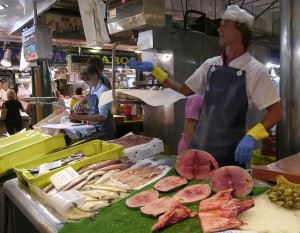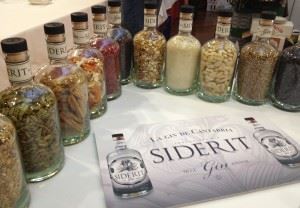Cantabria might not be the first region you think of when you think of Spanish cuisine but within Spain it’s becoming very fashionable to cook with Cantabrian ingredients and many of the local chefs have opened sister restaurants in Madrid to cater for the increase in popularity. We’ve been working from Northern Spain for the past two decades as travel specialists and we love Cantabrian food and want to make it as easy as possible for you to understand it and enjoy it too.
Eating Out in Cantabria in Northern Spain
Cantabria is a region that really celebrates the quality of its ingredients and menus are almost always seasonally driven. And in case that wasn’t enough, you’ll find the best of the neighbouring Basque and Asturian ingredients and recipes on the menus also. Want to know how you can get the best from the region?

Anchovies from Santona make a great present. One former regional head made a name for himself giving them to King Juan Carlos in Madrid. We can’t think of a better present – they travel well, taste delicious and are from here!
1 What to do when Eating Out in Cantabria (and the rest of the country):
- Watch what people are eating around you to make sure you’re eating the restaurant’s specialities. If you see people eating calamares (called rabas in Cantabria) order it. If you see them having stew, try it. Ask what the specials are. And if you don’t like what you see, don’t sit down – find somewhere else.
- Don’t be afraid to ask questions. If you see a pot of hot herby alcohol going to another table while you are out for a meal – ask what it is. You might be given a sample. (The herby drink is a tea with Puerto herbs served with Orujo liquer…)
- Translations in English aren’t always as helpful as they could be or may not be available at all. If you don’t understand something on menu, ask for clarification
- Stick to the local timetable to get the best food. It’s really worthwhile to adjust your own eating habits to local times whether that’s in a village or in a Michelin-star venue
2 Know Where You Are in Cantabria
Just as Spanish cuisine is very different from one region to the next – Cantabria cuisine varies from area to area. You shouldn’t expect vast arrays of fresh seafood in the Picos de Europa mountain range, nor should you expect to find wild boar stews in the restaurants on the coast.
3 Along The Coastline, you should try…
- Rabas or calamares (squid) are usually breaded or battered
- Cachon (cuttlefish) or chipirones (squid) cooked in its ink
- Caracolillos (periwinkles) are sometimes eaten with a wine or vermouth before lunch
- Mussels or salpicon de marisco which is a medley of seafood in a vinaigrette
- Crabs are tricky for a novice but are a very popular starter. Try the maseras which are often on offer at the weekends.
- Bonito del Norte is a Northern tuna. When in season, you’ll find it grilled, BBQd and stewed. Out of season, you’ll find it preserved in olive oil – and added to a salad or served with chilled roasted red peppers.
- Fresh sardines called boquerones – are grilled or battered
- Preserved anchovies in salads, on tapas, or on their own. Delicious with goat’s cheese on a dry bread. Santona is where the anchovies are preserved. You will not find a better anchovy.
- If you’re wondering what is the most expensive item – it’s percebes (barnacles) which are highly coveted in Cantabria and are charged by the kilo.
4 Go See
- The Mercado de la Esperanza in Santander (or any other food market on the coast). That’s where you’ll find the best selection of artisan produce. Downstairs for fish. Upstairs for cheeses, fruit and cured meats. While around the shops, keep an eye out for the new gin distilled in Torrelavega called Siderit – very nice.
- A food producer. Or a wine producer. We loved our recent private tasting at the Bodegas Vidular in Voto. The wine is wonderful and the views from the winery make the trip extra special. Pro-tip: Arrange a tapas tasting or book lunch, you will not regret it!
- Foodie events such as the Anchovy Festival in Santona where top chefs prepare their favourite anchovy recipes (and show off a bit) . Also consider the non-foodie festivals which often have a food element – e.g. the massive open-air fresh sardine BBQ for Dia del Carmen in Puertochico, Santander
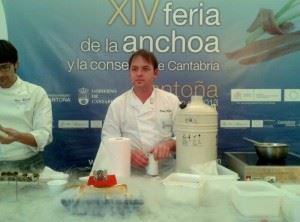
Ruben Abascal of Los Brezos Restaurant in Meruelo giving a demonstration at the Anchovy Festival in Santona
5 Go Eat
Try one of these chefs on the coast:
- Oscar Calleja at Annua Restaurant in San Vicente de la Barquera with a Michelin star since 2012 boasts the best sea views in the region. Local oysters feature amongst the beautifully presented dishes in a modern location that embraces the sea.
- Ruben Abascal at Los Brezos Restaurante in Meruelo prepares top class food at very affordable prices in the most unassuming of venues – a roadside café near Noja. Booking essential for his Tasting Menu.
- Javier Ruiz at Sambal Restaurant, Noja which is located inside the grounds of the golf course. Excellent service. Fish and seafood dishes are highly recommended.
6 In the Pasiego Valleys, you should try…
- Dairy products such as yoghurts & butters
- Queso de nata is a cream cheese made from Fresian cows
- Stews made using an olla ferroviaria – which is a large mobile cooking pot designed for rail workers in Southern Cantabria. The ultimate in slow food
- Buttery sponges called sobaos from Selaya. Usually served as a breakfast cake but equally good sliced and toasted to serve with pate as a starter. Try quesada also
- Leche frita literally means fried milk. This is a custard-like mix with cinnamon and orange zest that is battered. Sounds dubious but is actually very tasty

Coffee with sobao – a buttery sponge made in the Pasiego Valleys – is a typical breakfast in Cantabria

Have lunch at the Sonanes Palace in Villacarriedo. Lovely food and you’ll be dazzled by the beauty of the building
7 Go See
- Visit the cheesemaker La Jarradilla, near Selaya in the Pasiego Valleys – the dairy of Cantabria. Try the cheam cheeses and their light blue Divirin that has won more awards than we can count. Visit the farm and the cheese-making facilities and you’ll see why.
- Drive or take the train to Lierganes – one of the prettiest small towns in Cantabria – on Sunday morning for the medieval market where you’ll find many of the local cheeses on sale. Get in touch with Dougalls Brewery to see if you can visit and taste Andrew’s delicious craft beer Originally from London but living in Lierganes, Andrew’s beer is sold all over Spain and he is the godfather of the craft beer movement in the country.
- The Museum of Wet-Nurses in Valvanuz. You read that correctly. For 200 years royalty and nobility in Madrid and the South of Spain sought out wet-nurses from La Vega de Pas. The royal family used the services of the local doctor and priest in Selaya to hire its nurses. Others hired their nurses in person. In Granada there is a square called Plaza de las Pasiegas where the wet nurses would arrive and from where they would be employed. The Museum brings together photographs and memories of difficult times for the region.
8 Go Eat
- Ignacio Solana at Solana Restaurant, La Bien Aparecida, Ampuero is the third-generation of his family at this restaurant. Enjoy wonderful food surrounded by green fields and dairy herds. Ignacio was awarded a Michelin star in 2011.
- The Palacio de Sonanes in Villacarriedo is a stunning palace with an excellent traditional restaurant. The wine selection is interesting and the set-price menus offer exceptionally great value.
9 In the Picos de Europa, you should try…
- Queso picon is a strong creamy blue cheese that is served with steaks, or as a cheese platter.
- Stew – but please be aware that it is filling. The most typical is the cocido lebaniego that is cooked as a stew and served separately – first the soup, then the solids. We prefer the lighter cocido montanes – made with white beans rather than chick-peas and served together.
- Orujo – a grappa-like distilled liquer make from the residue of grapes used in wine-making. You can try the original, the herby version or the smoother cream which is very like Baileys
- Borono – a blood sausage – often served fried with an apple puree or caramelised onions
- Honey – usually served with desserts or on salads. Miel de Brezo is a wonderful product. If you spend a few hours in the countryside there, you’ll know why the honey tastes so good.
10 Go See
- The outdoor food market in Potes every Monday morning
- The Orujo Festival in Potes in October
- Orujo producers such as Sierra del Oso and El Coteron offer visits to their production facilities
- Visit Bodegas Rio Santo (pre-booking essential) just outside Potes in Esanos and try their award winning and rare Vino Lusia red wine made from 90 year old native mencia aka jaen grapes. A testament to the area’s micro-climate and an interesting wine too. Walk around the village and enjoy the traditional way of life. Also interesting is a visit to Bodegas Picos that produces red and white wines and Orujo.

The weekly market in Potes is a great place to find local produce and meet artisan producers. Photo credit: MJ&LM Ryan via photopin cc

Mountain stew, called cocido montanes, is made from beans, cabbage, potato, chorizo, pork belly, black pudding and smoked paprika. It’s a bit lighter than the lebaniego stew on offer in the Liebana Valley
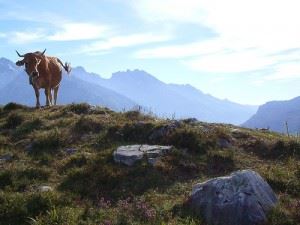
Tresviso – the home of the blue cheese called queso picon. Pic credit: Steven2358 via photopin cc
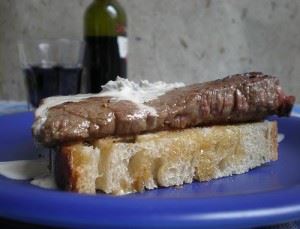
A fillet steak and local blue cheese in Liebana. Photo credit: Noema Pérez via photopin cc
11 Go Eat
- Hotel del Oso in Cosgaya is excellent for traditional food in beautiful and comfortable surroundings
- For the best views of the Picos go to Cahecho village – which is called the Balcony of the Picos and have some simply prepared yet tasty food at Pena Sagra or CasaLamadrid restaurants. It’s a very windy road up but you’ll be glad you went.
- Casa Cayo in Potes serves great traditional dishes
12 Plan Your Trip to Cantabria
Not yet here? Now you know what’s involved in eating out in Cantabria, what are you waiting for? If we have whet your appetite then tell us what cuisine you are interested in and we’ll recommend the best restaurants for you, tell you where to find the most interesting artisan producers and suggest festivals you might like to visit while in the area. We can arrange a driver or guide to take you to a local food market and take you for tapas in nearby bars or restaurants. Read our guide to Michelin-Star Dining in Cantabria, and our other guides to Cantabria, plus nearby Bilbao, San Sebastian & Northern Spain?


